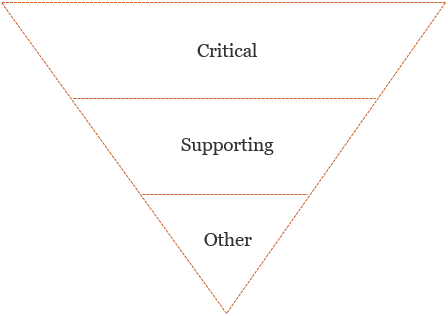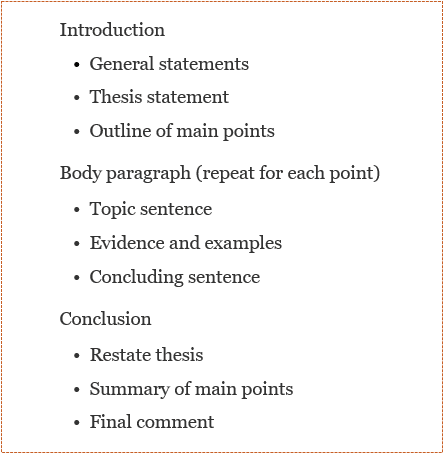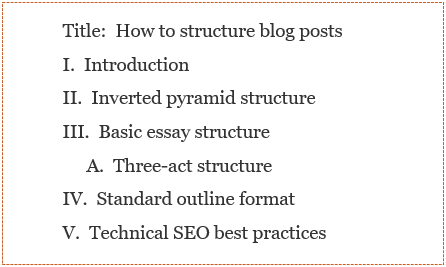How to structure blog posts
“Highest quality pages are created to serve a beneficial purpose and achieve their purpose very well.”—Google Search Quality Evaluator Guidelines, section 5.0, paragraph 1 (Oct. 14, 2020)
Introduction
There are many ways to optimize blog post structure, from the writing process to the HTML markup. The most important steps are knowing what readers are looking for and delivering it quickly and easily. More advanced writing finds the right structure or combines multiple structures. This article discuss how inverted pyramid structure, basic essay structure, standard outline format and some technical SEO best practices help optimize blog posts for readers and search.
Table of contents
Inverted pyramid structure
Searchers expect to find the information they need quickly and easily. Inverted pyramid writing structure serves this need by presenting information in the most helpful order. It puts the most important information at the beginning as part of a strong (detailed and interesting) lede. The most relevant supporting information or evidence follows. Background information and less relevant or related details are at the end.

Inverted pyramid writing structure
A simple inverted pyramid structure pre-writing process:
- 1. Determine the target search query (primary keyword)
- 2. Identify the searcher's most likely intent
- 3. Design the content to serve that single purpose
Basic essay structure (intro, body, conclusion)
With the core concept of the blog article set, basic essay structure refines it. Its three sections (intro, body and conclusion) define what's needed at each point of the article. This ensures important info is included and superfluous messaging is avoided.

Basic essay structure
Three-act structure (setup, confrontation, resolution)
When more storytelling is needed, consider borrowing from the playwright's three-act structure: setup, confrontation and resolution. The three-act structure is helpful when delivering complex info often found in basic essay structure subsections.
Standard outline format (HTML heading tags)
Also known as a Roman numeral outline, a standard outline identifies each section and subsection. This outline is used for HTML heading tag placement. Search engines use heading tags (not visible to readers) to understand the structure of the document.
The title of the document is marked <h1>; only one <h1> should be used on each blog post. The primary sections are labeled with a Roman numeral (I, II, III ...); each of these will be marked <h3>. Subsections of each are labeled with a capital letter (A, B, C ...); these will be marked <h4>. Further divisions are labeled with an Arabic numeral (1, 2, 3 ...); these will be marked <h5>. If needed, there are six levels of heading tags, from <h1> to <h6>.

Standard outline format
Technical SEO best practices
This section offers a quick review of technical SEO best practices for blog articles. This includes title and meta description, image file names and alt tags, structured data (schema), sitemap inclusion and more.
Title and meta description
The page title and meta description are what most often will display on the SERP (search engine results page). Page title is a direct ranking factor. It should closely match the <h1> element. While meta description is not a Google ranking factor, it's an opportunity to get searchers excited to read your article. This is called click-through rate optimization (CRO).
Image compression, file name and alt attribute
The W3C provides these guidelines for image alt attribute:
- • Alt text should describe the image if the image contains information
- • Alt text should explain where the link goes if the image is inside an <a> element
- • Use alt="" if the image is only for decoration
Schema markup
The set of rules outlined by schema.org help search engines learn about a page and its contents. There are many ways to optimize schema for blog posts. Schema structured data markup can be applied via JSON-LD (preferred), or Microdata (older, less preferred).
Sitemap inclusion
Be sure to include each blog post URL in the sitemap. Many content management systems do not include sitemap management. In those cases, a plugin will need to be added or a sitemap generation script must be set up. Manual sitemap updates are the least preferred option. For a basic example, view the bradleyporter.com sitemap (opens in a new tab).
While schema.org gives us structured data rules, sitemaps.org gives us sitemap protocol.
Accurate <lastmod> date
When search bots crawl sitemaps, they look for new URLs and <lastmod> tags. Bots compare <lastmod> (in W3C Datetime format) to the last crawl date. If <lastmod> is after the last crawl date, the page crawl is prioritized. Without accurate <lastmod> dates, it is more difficult for search bots to find fresh content on updated blog posts.